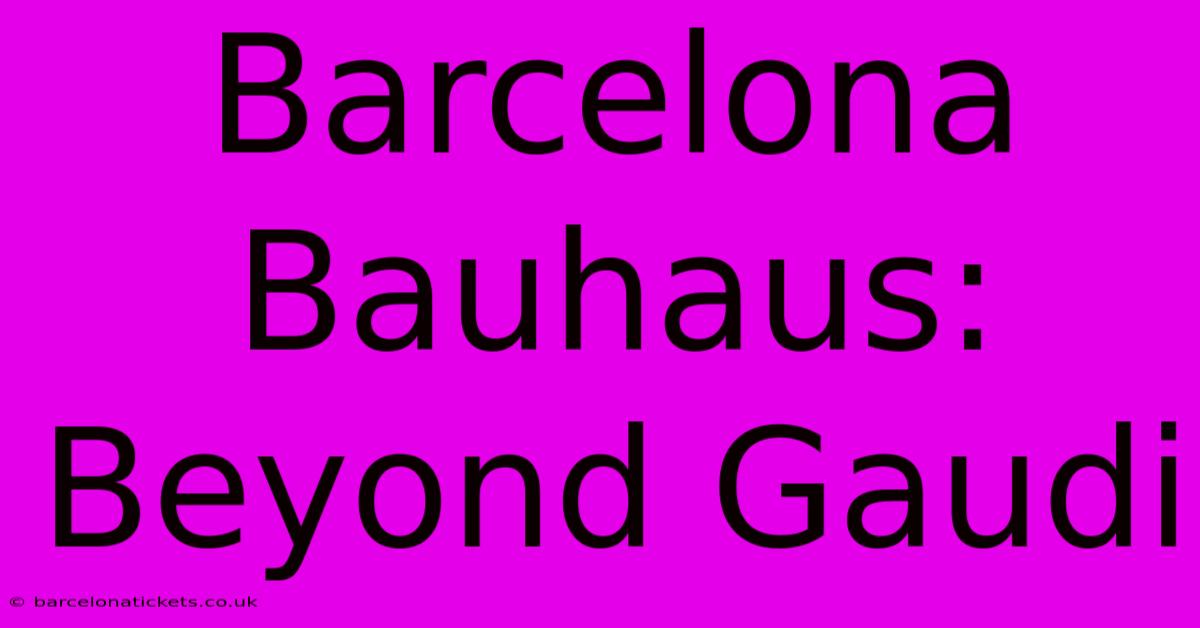Barcelona Bauhaus: Beyond Gaudi

Table of Contents
Barcelona Bauhaus: Beyond Gaudí
Barcelona is synonymous with Antoni Gaudí's whimsical Modernisme architecture. However, the city boasts a rich architectural history extending far beyond the iconic Sagrada Família. A lesser-known but equally significant movement that shaped Barcelona's cityscape is the Bauhaus influence, offering a fascinating counterpoint to Gaudí's flamboyant style. This article delves into Barcelona's Bauhaus legacy, exploring its unique expression and its enduring impact on the city's design landscape.
Understanding the Bauhaus Influence in Barcelona
While not as overtly present as in other European cities like Dessau or Weimar, the Bauhaus's impact on Barcelona is subtly yet powerfully felt. It's crucial to understand that Barcelona's Bauhaus wasn't a direct transplantation of the German school's principles. Instead, it manifested as a fusion of the Bauhaus ideals with the existing local architectural traditions and the burgeoning Modernist movement already flourishing in Catalonia.
Key Characteristics of Barcelona's Bauhaus Style:
- Functionality over Ornamentation: A core tenet of Bauhaus, this emphasis on practicality is evident in many Barcelona buildings from this period. Clean lines, simple forms, and a rejection of excessive decoration prevail.
- Integration of Art and Design: Like its German counterpart, Barcelona's Bauhaus embraced the unity of art and craft. This is reflected in the attention to detail in furniture design, interior spaces, and the overall aesthetic coherence of buildings.
- Use of Industrial Materials: The adoption of materials like steel, concrete, and glass, signifying a move away from traditional methods and embracing industrial progress, is a hallmark of this style.
- Emphasis on Light and Space: Barcelona's sunny climate and the prevailing Modernist appreciation for light heavily influenced the Bauhaus designs, leading to buildings with generous windows and open floor plans.
Notable Examples of Barcelona Bauhaus Architecture
While pinpointing specific buildings as purely "Bauhaus" can be challenging due to the hybrid nature of the style in Barcelona, several structures showcase strong Bauhaus influences:
1. The Hospital de Sant Pau (Sant Pau Hospital):
While architect Lluís Domènech i Montaner's masterpiece is primarily considered Modernisme, its incorporation of rational planning, clean lines in certain sections, and the use of industrial materials foreshadows Bauhaus principles. The hospital's sprawling complex demonstrates a focus on functionality and the efficient use of space, qualities central to the Bauhaus ethos.
2. Casa Bloc (Block House):
Designed by Josep Lluís Sert, this social housing project, built in the 1930s, is a closer approximation to the tenets of Bauhaus. Its repetitive modular design, simple geometric forms, and emphasis on affordable, functional living spaces clearly reflect the Bauhaus ideals of social responsibility and mass production. Casa Bloc serves as a prime example of Barcelona's embrace of functionalist principles.
3. Other Influenced Structures:
Many other residential buildings and public works from the 1930s and 40s in Barcelona subtly incorporate Bauhaus elements, showcasing a gradual shift towards a more streamlined and functional architectural language. Searching for buildings employing rational design, simple facades, and industrial materials can lead to the discovery of hidden gems showcasing the subtle yet significant presence of Bauhaus.
The Enduring Legacy
Barcelona's Bauhaus influence, though less overt than in other European cities, is a crucial part of the city's architectural narrative. It represents a fascinating interplay between a global architectural movement and the unique cultural and historical context of Catalonia. By exploring beyond the well-trodden path of Gaudí's Modernisme, we discover a richer and more nuanced understanding of Barcelona's architectural heritage. This understated yet significant presence of Bauhaus principles continues to inspire contemporary architects and designers in Barcelona and beyond. Understanding this hidden layer adds depth to the appreciation of Barcelona's diverse and dynamic architectural landscape.
Further Exploration:
To further delve into Barcelona's Bauhaus influence, consider researching the works of architects like Josep Lluís Sert, and exploring architectural archives and museums in Barcelona. By seeking out examples of rational design and functionalist principles in the city's architecture, you can uncover the often-unseen legacy of the Bauhaus movement in this vibrant Catalan capital.

Thank you for visiting our website wich cover about Barcelona Bauhaus: Beyond Gaudi. We hope the information provided has been useful to you. Feel free to contact us if you have any questions or need further assistance. See you next time and dont miss to bookmark.
Featured Posts
-
2015 Barcelona Jersey Messis Legendary Season
Apr 03, 2025
-
Your Guide To Barcelona Ski Resorts
Apr 03, 2025
-
Luxury And Romance Barcelona Wedding Packages
Apr 03, 2025
-
Barcelona Street Map The Most Up To Date Map
Apr 03, 2025
-
Forst In Barcelona A Walk Through History
Apr 03, 2025
